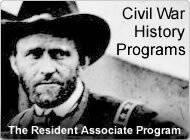
Civil War Guide to Montgomery County, Maryland, by Charles T. Jacobs
The Smithsonian Associates Civil War E-Mail Newsletter, Volume 7, Number 8
In 1860, Montgomery County had a population of 18,322, including some 5,500 slaves and 1,500 free blacks. Maryland would remain a slave holding state until the Maryland Constitution of 1864 outlawed slavery on November 1, 1864.
Politically, voters in the county were split among the several candidates for President in the 1860 elections. Of the 2,400 votes cast in the county, 46% voted for John C. Breckinridge, Southern Democrat; 47% for John Bell of the Constitutional Union Party; 4% for Stephen A. Douglas, the Northern Democrat; and, 2% (just 50 votes) for Republican Abraham Lincoln. President Lincoln was still in disfavor four years later when he received 25% of the county's vote to 75% for George B. McClellan.
Montgomery County was perhaps unique in the combination of factors which affected its citizens throughout the war. As a county of a border state which would possible secede from the Union and in immediate proximity to the nation's capital, it was subjected to early occupation by federal civil and military authorities. In several instances, it experienced major "invasions" by Confederate and Federal forces moving through its territory. Its citizenry was split between sympathy with the Union and with the Confederacy, occasionally, and for most part temporarily, turning long-time friends and neighbors against each other.
As a slave holding border county with many southern sympathizers, the county was assured of an early occupation by federal military forces. The homes of suspected pro-southerners were raided, any arms found were seized, and the owners were arrested on a myriad of dubious charges and imprisoned without hearing or trial. Meetings were monitored and the more vocal anti-Union speakers arrested. The local newspaper, The Montgomery County Sentinel, was suppressed on several occasions by the arrest and imprisonment of its editor.
Politically and emotionally, the citizens were split in their allegiance to the north or south. The citizens of northwestern Montgomery County, with more social, economic, and personal ties to adjacent Loudoun County, Virginia, tended to sympathize with the south, while the lower county was more evenly divided between the two governments. Many of the southern leaning men "went South" early in the war to join such Rebel units as the 35th Battalion, Virginia Cavalry, the 1st Virginia Cavalry, and the 1st Maryland Cavalry, CSA. Those who remained behind--at least the more visible and vocal--were periodically imprisoned in Old Capitol Prison in Washington as a result of their views. Conversely, a few pro-Union citizens were subject on rare occasion to capture and/or harassment by Confederate forces in temporary control of areas of the county.
Compared with its neighboring counties in Virginia, Montgomery County suffered relatively little physical damage as a result of actual conflict between Union and Confederate forces. Considerable economic damage was caused, however, by the occupation of many parts of the county by federal forces camped for extended periods in the towns, fields, and forests. Damage frequently was inflicted on the Chesapeake and Ohio Canal by both sides during the conflict, creating hardships on those dependent on the operation of the canal.
Recovery from wartime wounds came relatively easily for Montgomery County. The comparatively little physical damage was soon repaired. Prewar friendships were restored, and returning Confederate veterans readily assimilated and, for the most part, resumed their prewar positions in county society, businesses, and government.

Thanks to Mary Kay Harper, Executive Director of the Montgomery County Historical Society, for permission to use this article. For more information about the history of the largest, most picturesque, and most diverse county in Maryland, visit their website at: http://www.montgomeryhistory.org/.

